

![]()
HERDING DOGS OF ASIA
THE HERDING DOGS OF MONGOLIA, CHINA, AND TIBET
(See the map that accompanies The Herding Dogs of Russia for ethnic groups mentioned in this article)
MONGOLIA
In Mongolia nomadic animal husbandry occupies 75% of the land area. Fifty-eight percent of the livestock are sheep, raised for meat, milk, and wool. There are minority ethnic groups living in Mongolia, as in Russia, most of whom speak a Mongolic language. The largest of these groups are the Buryat, nomadic sheep herders.
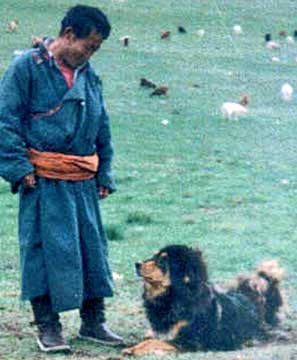 Left, a Mongolian sheep herder with his dog. (Photo courtesy of molosserdogs.com.)
Left, a Mongolian sheep herder with his dog. (Photo courtesy of molosserdogs.com.)
Mongolia does not seem to have a herding dog per se, but it has dogs that sometimes serve a dual purpose of guarding (its primary function) and herding. Caroline Humphrey, an anthropologist, says:
"[The] xotoc noxoi...are domestic dogs responsible for protecting the herds belonging to a camp....[It] should be as big, or bigger, than a wolf, shaggy, and strong. It should have a loud, resounding bark to frighten wolves, even those far away in the hills...Dogs are generally tied up on a long chain, but even so they are a danger to any stranger approaching the yurt...The xotoc dog lives outside all year round with only a small shelter of frozen dung, unroofed, provided in winter. This is really just a wind-break...The main job of the xotoc noxoi is protection from wolves and thieves. Overnight, dogs are tied up at the four corners of the...area where the sheep and goats are huddled together, usually in the middle of a group of yurts. If wolves howl in the night, someone goes out and unties the dogs so they can be free to attack. Xotoc dogs are not used much as sheep-dogs in the English manner, i.e. to separate and drive sheep, although they sometimes have this function."
Although Humphrey does not say, these dogs are more likely to be of the Tibetan Mastif type, also known as the Gharzh or Bankhar in Mongolia. This large Molosser-type livestock guardian dog would be a match for any wolf. It carries its tail over its back like a spitz, but its ears are held down and its muzzle is somewhat short. When it is at full alert, the hair stands up on its neck like a lion's mane, giving the dog a truly fearsome appearance. The more moderately proportioned variety is often called the "nomad type".
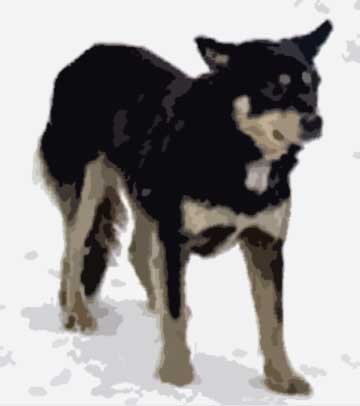 Another dog found in Mongolia is the "Taiga" (probably short for "dog of the taiga"). It is a Siberian laika dog that came to Mongolia with the Buryats, that is used for hunting, though it is probably a more all-purpose dog. The Buryats are a major northern subgroup in Mongolia, and they speak a Mongolic language. Perhaps their language was not always Mongolic, but in the 13th century, Mongolians road north and conquered them. The Buryats are horse and sheep pastoralists who can be found on both sides of the Russian-Mongolian border.
Another dog found in Mongolia is the "Taiga" (probably short for "dog of the taiga"). It is a Siberian laika dog that came to Mongolia with the Buryats, that is used for hunting, though it is probably a more all-purpose dog. The Buryats are a major northern subgroup in Mongolia, and they speak a Mongolic language. Perhaps their language was not always Mongolic, but in the 13th century, Mongolians road north and conquered them. The Buryats are horse and sheep pastoralists who can be found on both sides of the Russian-Mongolian border.
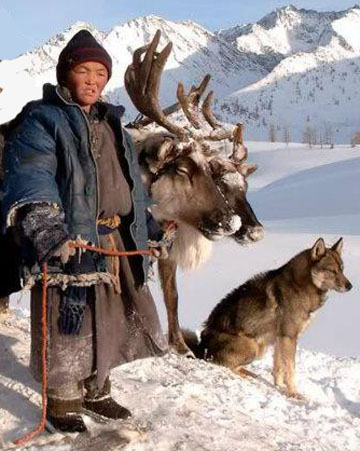
Right, a Buryat Taiga or laika dog. "(From an original photo by photographer, Susan Gilman.)
Left, a Tsaatan reindeer herder with his laika-type dog. (Detail from an original photo by Hamid Sardar-Afkhami.)
Below right, a Mongolian Dukha group migration. Their white laika dog can be seen in the foreground. (Photo courtesy of Alan Wheeler.)
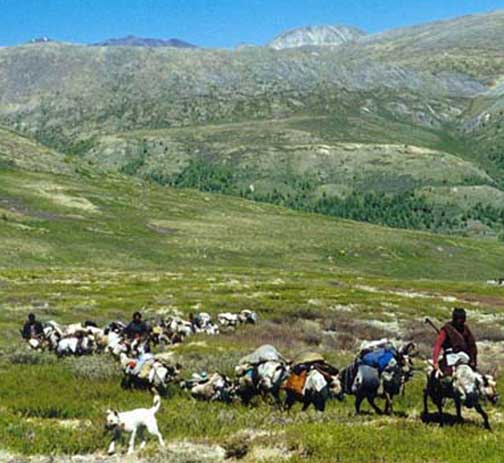 A large group of Sayan-Turkic-speaking nomadic pastoralists in Mongolia are the Tuvans. They have raised herds of goats, sheep, camels, reindeer, cattle, and yaks for at least a thousand years in Siberia. In Mongolia they are known as Dukha or Tsaatan. Those who are reindeer herders ride their reindeer. There are only a small number of Dukha left, and their community crosses the Russian-Mongolian border, but the border cuts them off from each other, and they are the only reindeer herding culture in Mongolia. They live in the Mongolian taiga. The reindeer permeates their culture and language, which is very endangered. They do not use their reindeer for meat but only milk products, transport, and draft. Instead they hunt elk (wild reindeer), moose, boar and bear for meat. Their culture is at risk today from agriculture, industrialization, forced settlement, and enforcement of government regulations and there are only about 500 Dukha left. They have dogs that are a type of Siberian Laika that are primarily used for hunting. According to Alan Wheeler, "When not hunting, the dogs stay in the camp [as watchdogs]. During the day, when the herds are released to graze, dogs generally stay in camp and have little interaction with the herds."
A large group of Sayan-Turkic-speaking nomadic pastoralists in Mongolia are the Tuvans. They have raised herds of goats, sheep, camels, reindeer, cattle, and yaks for at least a thousand years in Siberia. In Mongolia they are known as Dukha or Tsaatan. Those who are reindeer herders ride their reindeer. There are only a small number of Dukha left, and their community crosses the Russian-Mongolian border, but the border cuts them off from each other, and they are the only reindeer herding culture in Mongolia. They live in the Mongolian taiga. The reindeer permeates their culture and language, which is very endangered. They do not use their reindeer for meat but only milk products, transport, and draft. Instead they hunt elk (wild reindeer), moose, boar and bear for meat. Their culture is at risk today from agriculture, industrialization, forced settlement, and enforcement of government regulations and there are only about 500 Dukha left. They have dogs that are a type of Siberian Laika that are primarily used for hunting. According to Alan Wheeler, "When not hunting, the dogs stay in the camp [as watchdogs]. During the day, when the herds are released to graze, dogs generally stay in camp and have little interaction with the herds."
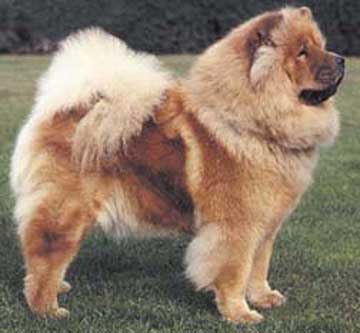
Left, a Chow Chow. (Photo courtesy of Students of the World.)
Another dog that may be used for herding in Mongolia is the Chow Chow. This breed is associated with China, but may have originated in Mongolia and is said to be a herding/guardian/hunting dog. It is a medium-sized spitz-type dog, though with specific characteristics that are not present in the other spitz types, namely a blue tongue, stiff back legs which gives a stilted gait, a lion-like mane, and a very short muzzle. It also comes in a short-furred variety.
CHINA
China, like Russia and Mongolia, has many ethnic and linguistic groups that are as different from one another as they are from the majority Han population, and it is even more difficult to find information on these groups. China has been and is in the process of erasing the culture and languages of "minority peoples" through forced settlement, agriculture, industrialization, and the resettlement of Han people into areas where once other ethnic groups lived.
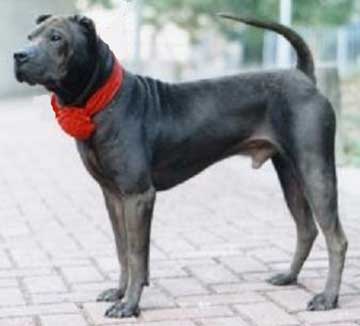 Right, a traditional Shar-Pei. (Photo by "K9quan" from Wikipedia and reprinted with permission under the terms of the GNU Free Documentation License.)
Right, a traditional Shar-Pei. (Photo by "K9quan" from Wikipedia and reprinted with permission under the terms of the GNU Free Documentation License.)
In rural western China, sheep, goats, and camels are raised by nomadic herders. Other types of livestock are farmed or raised in factory farms. However, according to Leta Hong Fincher of the World Tibet Network News, "nomadic herders are quickly vanishing as the government moves ahead with settlement programs it hopes will speed the development of the poor western regions. One such place is the province of Qinghai, bordering Tibet, where Mongolian and Tibetan nomads have herded for centuries." This was reported in 2001. Ten years later, the same thing was happening in Inner Mongolia, where the Ewenki, a minority nomadic reindeer herding group was being forcibly settled. The Ewenki of China are the same people as the Evenks of Siberia, and speak a Manchu-Tungus language. They represent about 30,000 people and, according to Jonathan Kaiman of the Los Angeles Times, "are among hundreds of thousands of nomadic herders from the country's northern hinterlands who have [been forced] into permanent settlements". The dogs they have are hunting dogs, possibly the same or similar to the Siberian laikas, and those few people that still lead a nomadic life still hunt squirrel and deer. They used to hunt moose, bear, and wild boar, and only used the reindeer for draft. Now they raise reindeer collectively to make a living.
The Chow Chow, mentioned above is a Chinese spitz-type, but it may have originated in Mongolia. It was sometimes used for herding. The Shar-Pei, a wrinkled dog that may be related to the Chow Chow, also having a blue tongue, was also sometimes used as a hunter, general farm dog, and herder. It is an ancient breed. The "traditional" variety does not have all the wrinkles that the Western type does.
TIBET
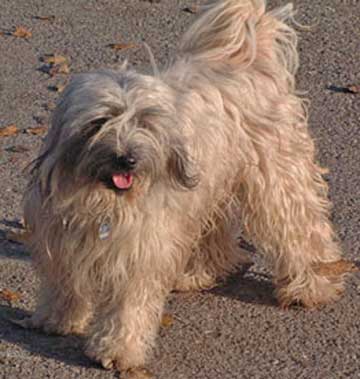 Left, a Tibetan Terrier. (Photo by "Chauffeurin" from Wikipedia and reprinted with permission under the terms of the GNU Free Documentation License.)
Left, a Tibetan Terrier. (Photo by "Chauffeurin" from Wikipedia and reprinted with permission under the terms of the GNU Free Documentation License.)
Tibet's economy is also dominated by livestock raising. The yak is an integral part of Tibetan life, and sheep, cattle goats, camels, dzo (crosses between yaks and domestic cattle), and horses are also raised. If any dog is used for herding it would be the Tibetan Terrier, which is not a terrier at all, but a medium-sized dog similar in appearance to the Bearded Collie. This dog was used as a farm dog, herding dog, and guardian. The other dog used for guarding and herding is the Tibetan Mastiff, described above. However, Tibetans are being moved to resettlement communities as well, forced to give up their nomadic way of life, their livestock, and of course, their dogs.
Special thanks to Caroline Humphry, Libby Peachey, and Alan Wheeler.
Copyright © 2014 by Carole L. Presberg
Resources:
Author known as "Mongolia Social Manager". "Mongolian Dog Types", November 16, 2010 (www.mytripblog.org/pg/blog/mongolia-social-manager/read/17563/mongolian-dog-types).
Fincher, Leta Hong. "Nomadic Herders Vanishing in China", World Tibet Network News, 2001.
Humphrey, Caroline. "Some Notes on the Role of Dogs in the Life of Mongolian Herdsmen, Journal of the Anglo-Mongolian Society, Cambridge, England, December 1976
Kaiman, Jonathan. "Chinese reindeer wrangler won't be herded into city", Los Angeles Times, December 13, 2011.
Keay, Morgan G. "The Tsaatan Reindeer Herders of Mongolia: Forgotten Lessons of Human-Animal Systems", Encyclopedia of Animals and Humans, ca. 2006.
Sardar-Afkhami, Hamid. Photographer (http://hamidsardarphoto.com/).
Students of the World, a French non-profit association, whose aim and ambition is to open the doors of the world's cultures to young people (http://www.studentsoftheworld.info/sites/animals/45966.php).
Wen, Philip. "Walls close in on Tibetan nomads promised better life", The Sydney Morning Herald, February 20, 2012.
Wheeler, W. Alan. From private correspondence.
Wikipedia, "Buryats" (en.wikipedia.org/wiki/Buryats).
Wikipedia, "China" (en.wikipedia.org/wiki/China).
Wikipedia, "Mongolia" (en.wikipedia.org/wiki/Mongolia).
Wikipedia, "Shar Pei" (en.wikipedia.org/wiki/Shar_Pei).
Wikipedia, "Tibet" (en.wikipedia.org/wiki/Tibet).
Wikipedia, "Tibetan Mastiff" (en.wikipedia.org/wiki/Tibetan_Mastiff).
Wikipedia, "Tibetan Terrier" (en.wikipedia.org/wiki/Tibetan_Terrier).
Return to
![]()
BORDER COLLIE COUSINS
THE OTHER WEB PAGES WE MAINTAIN
These web pages are copyright ©2014
and maintained by webmeistress Carole Presberg
with technical help from webwizard David Presberg
ALL RIGHTS RESERVED
If you are interested in using ANY material on this website, you MUST first ask for permission.